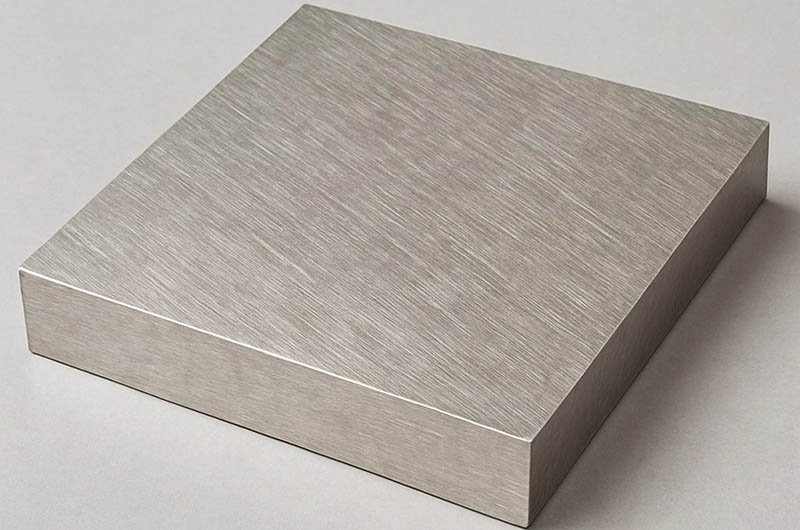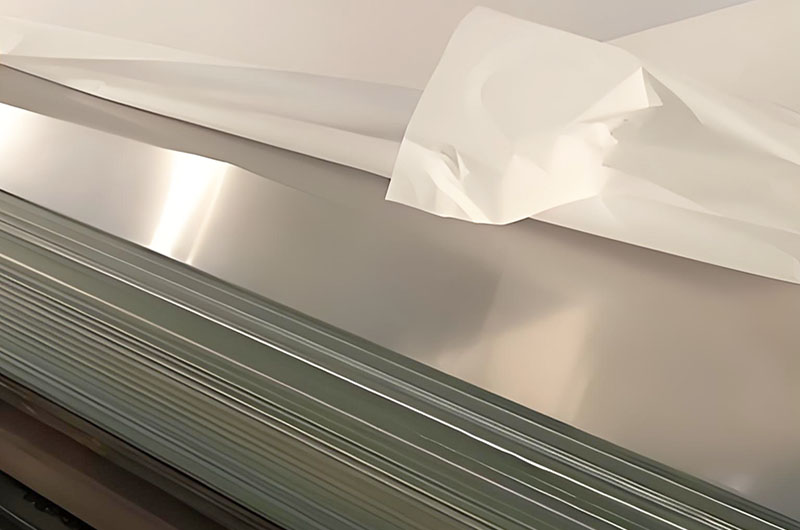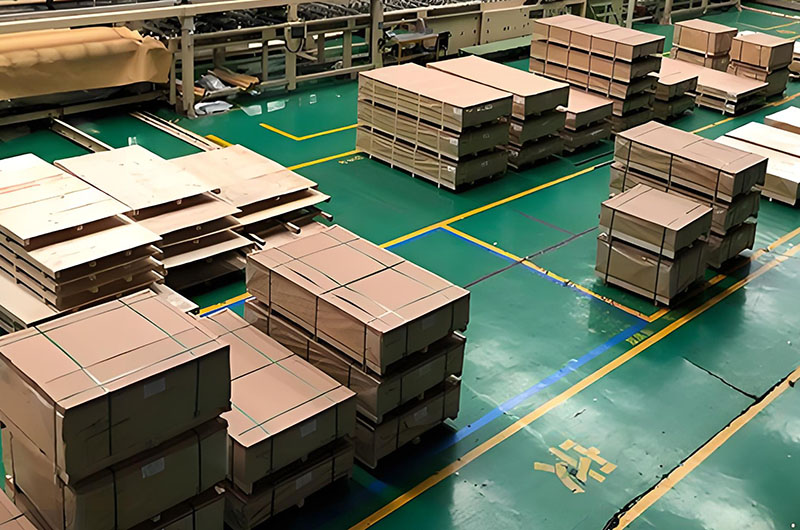3005 Aluminum Plate Sheet
3005 alloy is a non-heat-treatable wrought aluminum-manganese-magnesium alloy that offers medium strength (higher than the 1000 series), excellent formability, weldability, and corrosion resistance. Its typical composition consists of approximately 95.7% to 98.8% aluminum, 1.0% to 1.5% manganese, and 0.2% to 0.6% magnesium, making it well-suited for humid or mildly corrosive environments.
3005 aluminum covers various tempers such as O (annealed) and H12-H38 (various degrees of cold work hardening), adapting to different forming requirements.
Common temper states (such as O, H14, H22) allow strength and ductility to be adjusted through cold working. As a sheet product, 3005 is widely used in air conditioner casings, refrigerator panels, building cladding, cookware, and food processing equipment due to its combination of formability and durability.
3005 aluminum plate is a non-heat-treatable wrought alloy in the 3000 series (Al-Mn) and is known for its balanced strength, corrosion resistance, and formability.

What is 3005 aluminum?
3005 aluminum alloy is a non-heat-treatable wrought alloy consisting primarily of aluminum and manganese, with manganese ranging from 1.0% to 1.5%. This composition improves its strength and corrosion resistance compared to 3003 alloy.
- Alloy Group: 3XXX
- Main Alloying Element: Manganese
3005 aluminum sheet is an aluminum alloy with manganese as the primary alloying element, and a small amount of magnesium is added to its composition, making it stronger than the 3003 aluminum alloy. 3005 aluminum alloy is widely used in fields requiring good corrosion resistance, formability, and weldability, making it highly competitive in the market, especially in the field of rust-resistant aluminum plates.
3005 Aluminum Plate Features
- Material Classification: Belongs to the 3000 series aluminum-manganese alloy, with manganese as the main element (content 1.0–1.5%), combining rust resistance with higher strength; the manufacturing process is mature.
- Mechanical Properties: Strength is about 20% higher than that of 3003 aluminum plate.
- Corrosion Resistance: Performs excellently in humid environments; suitable for chemical and marine corrosive conditions.
3005 Aluminum Plate Standards
- Series: 3000 series (manganese alloy), non-heat treatable
- UNS Number: A93005
- EN Designation: EN AW-3005; conforms to EN 573-3 and EN 485-2 standards
- ASTM B209
- EN573
- EN485
Haomei Aluminum can provide 3005 aluminum alloy products in the form of: 3005 aluminum plate, 3005 aluminum coil, 3005 aluminum strip, 3005 aluminum rod, 3005 aluminum profile.
3005 Aluminum Sheet Plate Properties
- Strength: The strength of 3005 aluminum plate is about 20% higher than that of 3003 aluminum alloy, while maintaining a low density, making it suitable for applications that require higher strength.
- Corrosion Resistance: 3005 aluminum plate has excellent corrosion resistance, especially in environments with high humidity, making it an ideal choice in many industrial sectors, particularly for applications requiring high rust resistance.
- Formability: 3005 aluminum plate has good formability and is suitable for various processing methods such as bending and stamping, maintaining stable performance and good appearance during forming.
- Plasticity: 3005 aluminum plate has good plasticity in the annealed state, good plasticity in semi-cold quenching, and lowest plasticity in cold quenching.
- Anodizing Performance: 3005 aluminum plate is easy to anodize, and the anodized surface is more suitable for later processes like color spraying.
- Weldability: 3005 aluminum plate has good weldability and can be welded using common aluminum alloy welding methods, such as TIG and MIG welding.
Common 3005 Aluminum Sheet Plate Metal Tempers
- 3005-H12 Aluminum
- 3005-H14 Aluminum
- 3005-H16 Aluminum
- 3005-H18 Aluminum
- 3005-H19 Aluminum
- 3005-H22 Aluminum
- 3005-H24 Aluminum
- 3005-H26 Aluminum
- 3005-H28 Aluminum
- 3005-O Aluminum

Haomei Aluminum 3005 Aluminum Plate Specifications
| Aluminum alloy | 3005 Aluminum sheet |
| Temper | O, H12, H14, H16, H18, H19, H22, H24, H26, H28, H112, etc. |
| Thickness (mm) | 0.1-500 |
| Width (mm) | 100-2650 |
| Length (mm) | 500-16000 |
| Application examples | Aluminum substrate for color coating, lamp housing and holder, Aluminum shutters, curtain wall, etc. |
Equivalents of AA 3005
UNS A93005, ISO AlMn1Mg0.5, Aluminium 3005, AA3005, Al3005
3005 Aluminum Plate Processing and Surface Treatment
- Forming and Welding: Excellent rolling and deep drawing capabilities; easy to weld using all standard processes
- Surface Treatment: Suitable for anodizing, painting, or coil coating to enhance corrosion resistance and appearance
3005 Aluminum Plate Advantages
- Excellent Corrosion Resistance: 3005 aluminum alloy exhibits outstanding oxidation resistance, suitable for environments requiring corrosion resistance such as humid, acidic, or alkaline conditions.
- High Formability and Workability: This aluminum alloy has excellent formability and can be processed using common aluminum alloy techniques such as stamping, bending, and rolling.
- Strength: Approximately 20% stronger than 3003 aluminum, making it an ideal choice for structural applications.
- Anodizing Capability: Easily anodized to enhance surface durability and aesthetics.
- Good Weldability: 3005 aluminum plate can be welded using various common methods such as TIG (Tungsten Inert Gas welding) and MIG (Metal Inert Gas welding), and welded joints have good strength and corrosion resistance.
- Moderate Price: Although 3005 aluminum plate is more expensive than 1000 series aluminum alloys, its cost-performance ratio offers competitive advantages, making it an excellent choice for many applications.
Performance Comparison of 3005 Aluminum Plate
- Compared to 3003 Aluminum Plate: 3005 aluminum plate is about 20% stronger than 3003 aluminum plate, but both have similar formability and weldability. 3005 aluminum plate is more suitable for applications requiring higher strength.
- Compared to 5005 Aluminum Plate: 5005 aluminum plate has better corrosion resistance than 3005 aluminum plate, particularly in marine environments, but 3005 aluminum plate has higher strength and better cost-performance ratio, making it more suitable for general industrial applications.
3005 aluminum plate, with its higher strength, excellent corrosion resistance, good formability, and weldability, is widely used in various fields, especially in air conditioning, refrigeration, construction, pressure vessels, heat sinks, etc. As a high-performance aluminum alloy material, it is suitable for industrial applications that require high strength, corrosion resistance, and good processing capabilities, and its moderate price makes it an ideal choice in many industrial sectors.
Corrosion Resistance
3005 aluminum plate has good corrosion resistance and is suitable for use in harsh environments.
Formability
3005 aluminum sheet has excellent formability and can be easily formed through various manufacturing processes, which is crucial for industries such as automotive, construction and packaging.
Weldability
3005 aluminum plate has good weldability and is suitable for most welding techniques, including MIG and TIG welding.
Surface Finish
The smooth surface of 3005 aluminum plates can be finished in a variety of ways, including anodizing, painting, and powder coating, to enhance their aesthetic appeal.
3005 Aluminum Plate Chemical Composition
The main alloying element in 3005 aluminum plate is manganese, typically present at around 1.0-1.5%. In addition, magnesium (Mg) is added to the alloy, which gives it higher strength than the 3003 aluminum alloy.
| Chhemical Element | Content (%) |
| Aluminum, Al | 95.7 - 98.8 |
| Manganese, Mn | 1- 1.5 |
| Iron, Fe | ≤ 0.70 |
| Silicon, Si | ≤ 0.60 |
| Copper, Cu | ≤ 0.30 |
| Zinc, Zn | ≤ 0.25 |
| Magnesium, Mg | 0.20 - 0.60 |
| Chromium, Cr | ≤ 0.10 |
| Titanium, Ti | ≤ 0.10 |
| Other (each) | ≤ 0.050 |
| Other (total) | ≤ 0.15 |
Typical Mechanical Properties Data of Aluminum 3005
| Alloy-Temper |
Tensile Strength (ksi) |
Yield Strength (ksi) |
Elongation (%) |
| 3005-O | 20 | 8 | 22 |
| 3005-H14 | 29 | 28 | 4 |
| 3005-H18 | 37 | 36 | 2 |
3005 Aluminum Plate Sheet Mechanical Properties at different size and heat treatment
| Alloy / Temper | Specified Thickness Range | Ultimate | Yield | Elongation Percent Min. in 2 in. or 4D | ||
| Min. | Max. | Min. | Max. | |||
| 3005 / O | .006 - .007 | 17 | 24 | 6.5 | - | 10 |
| .008 - .012 | 17 | 24 | 6.5 | - | 12 | |
| .013 - .019 | 17 | 24 | 6.5 | - | 14 | |
| .020 - .031 | 17 | 24 | 6.5 | - | 16 | |
| .032 - .050 | 17 | 24 | 6.5 | - | 18 | |
| .050 - .249 | 17 | 24 | 6.5 | - | 20 | |
| 3005 / H12 | .017 - .019 | 20 | 27 | 17 | - | 1 |
| .020 - .050 | 20 | 27 | 17 | - | 2 | |
| .051 - .113 | 20 | 27 | 17 | - | 3 | |
| .114 - .161 | 20 | 27 | 17 | - | 4 | |
| .162 - .249 | 20 | 27 | 17 | - | 5 | |
| 3005 / H14 | .009 - .031 | 24 | 31 | 21 | - | 1 |
| .032 - .050 | 24 | 31 | 21 | - | 2 | |
| .051 - .113 | 24 | 31 | 21 | - | 3 | |
| .114 - .249 | 24 | 31 | 21 | - | 4 | |
| 3005 / H16 | .006 - .031 | 28 | 35 | 25 | - | 1 |
| .032 - .113 | 28 | 35 | 25 | - | 2 | |
| .114 - .162 | 28 | 35 | 25 | - | 3 | |
| 3005 / H18 | .006 - .031 | 32 | -- | 29 | - | 1 |
| .032 - .128 | 32 | -- | 29 | - | 2 | |
| 3005 / H19 | .006 - .012 | 34 | - | - | - | - |
| .013 - .063 | 34 | - | - | - | 1 | |
| 3005 / H25 | .006 - .019 | 26 | 34 | 22 | - | 1 |
| .020 - .031 | 26 | 34 | 22 | - | 2 | |
| .032 - .050 | 26 | 34 | 22 | - | 3 | |
| .051 - .080 | 26 | 34 | 22 | - | 4 | |
| 3005 / H26 | .006 - .019 | 28 | 36 | 24 | - | 1 |
| .020 - .031 | 28 | 36 | 24 | - | 2 | |
| .032 - .050 | 28 | 36 | 24 | - | 3 | |
| .051 - .080 | 28 | 36 | 24 | - | 4 | |
| 3005 / H27 | .006 - .019 | 29.5 | 37.5 | 26 | - | 1 |
| .020 - .031 | 29.5 | 37.5 | 26 | - | 2 | |
| .032 - .050 | 29.5 | 37.5 | 26 | - | 3 | |
| .051 - .080 | 29.5 | 37.5 | 26 | - | 4 | |
| 3005 / H28 | .006 - .019 | 31 | - | 27 | - | 1 |
| .020 - .031 | 31 | - | 27 | - | 2 | |
| .032 - .050 | 31 | - | 27 | - | 3 | |
| .051 - .080 | 31 | - | 27 | - | 4 | |
3005 Aluminum Plate Sheet Thermal Properties
| Properties | Metric | Imperial |
| Thermal expansion co-efficient (@20-100°C/68-212°F) | 23.9 µm/m°C | 13.3 µin/in°F |
| Thermal conductivity | 160 W/mK | 1110 BTU in/hr.ft².°F |
3005 Aluminum Plate Applications
3005 aluminum plate is used for processing parts that require good formability, high corrosion resistance, good weldability, or parts that require these properties and require strength higher than 1000 series aluminum alloys.
3005 aluminum plate is commonly used in humid environments such as air conditioners, refrigerators, and car bottoms. It is also commonly used in building materials and colored aluminum plates. 3005 aluminum plate has good formability, weldability, and corrosion resistance. It is used for processing parts and components that require good forming performance, high corrosion resistance and good weldability, or work that requires these properties and higher strength than 1000 series alloys, such as kitchen utensils, food and chemical product processing and storage equipment, tanks and cans for transporting liquid products, various pressure vessels and pipes processed with thin plates, general utensils, heat sinks, cosmetic panels, photocopier rollers, and ship materials.
3005 aluminum plates are often used in humid environments such as air conditioners, refrigerators, car bottoms, and oceans. They are also often used in general objects such as building materials, ship materials, colored aluminum plates, kitchen utensils, radiators, battery shells, and processing pipelines. They are also often used in building materials and colored aluminum.
The outstanding characteristics of 3005 aluminum plate make it widely used in various fields, particularly where corrosion resistance, durability, and good formability are required.
| Application | Description |
| Air Conditioning and Refrigerators | 3005 aluminum plate is widely used in the manufacture of air conditioner housings, refrigerator evaporators, and condensers, with good corrosion resistance, suitable for humid, low-temperature environments, and long-term use without corrosion. |
| Car Underbody | 3005 aluminum plate is commonly used in automobile chassis, body shells, etc., due to its high strength and good corrosion resistance, making it suitable for long-term use in the undercarriage. |
| Food and Beverage Packaging | 3005 aluminum plate is used in can lids and bodies, providing corrosion resistance to ensure the safety and integrity of food and beverages. |
| Electronics | 3005 aluminum plate is commonly used in electronic device enclosures, offering good conductivity, lightweight, and corrosion resistance, making it an ideal choice for electronic device housings. |
| Building Materials | 3005 aluminum plate is widely used in exterior wall decoration, roofing panels, window frames, etc., due to its strong weather resistance, good processing performance, and ability to withstand variable climate conditions while maintaining long-term beauty and durability. |
| Pressure Vessels and Pipelines | 3005 aluminum plate is widely used in the chemical, food processing, and liquid transportation industries, suitable for manufacturing liquid tanks, chemical containers, storage tanks, etc., with excellent corrosion resistance and formability. |
| Heat Sinks | 3005 aluminum plate, due to its excellent thermal conductivity and high strength, is commonly used in the production of heat dissipation components for electrical equipment and electronic products. |
| Shipbuilding Materials | 3005 aluminum plate has good resistance to seawater corrosion, making it widely used in ship hulls, bulkheads, and other areas, suitable for shipbuilding. |
| Kitchenware and Chemical Product Handling Devices | 3005 aluminum plate is widely used in kitchen utensils (such as cookware, baking trays, and pots) and chemical product handling and storage devices (such as chemical tanks and storage vats), offering high corrosion resistance and good formability. |

3005 Aluminum Comparison with Similar Alloys
| Alloy | Strength vs. 3005 | Corrosion Resistance |
| 3003 | Lower | Comparable |
| 3105 | Higher | Slightly Better |
| 5052 | Higher | Inferior |
3005 Aluminum Plate Production Description
- Non-heat treatable: Performance is enhanced through cold working (such as rolling and stretching).
- Annealing: Heated to 300–400°C to restore ductility.
What is the difference between 3003 and 3005 aluminum?
3003 and 3005 aluminum are both members of the 3000 series of aluminum alloys, known for their excellent corrosion resistance and good workability.
The primary difference between 3003 and 3005 aluminum lies in their mechanical properties and composition. 3005 aluminum has higher strength due to its increased manganese content, making it suitable for applications requiring more strength. Both alloys provide excellent corrosion resistance and good workability, but the choice between them depends on the specific strength requirements and application needs.
| Property | 3003 Aluminum | 3005 Aluminum |
| Corrosion Resistance | Excellent | Excellent |
| Workability | Good workability, easy to machine and weld | Good workability, slightly higher strength |
| Applications | Cooking utensils, storage tanks, heat exchangers, thin-walled components | Roofing sheets, wall panels, beverage cans |
Products you may be interested in
Further reading
Users viewing this material also viewed the following
- 3005 Aluminum Plate for Battery Shell
- 3005 Aluminum Plate for Curtain Walls
- 3005 Pre-painted Aluminum Coil
- 3005 Aluminum Disc for Cookware
- 3005 Aluminum Coil Strip for Blinds
Recommended Content
